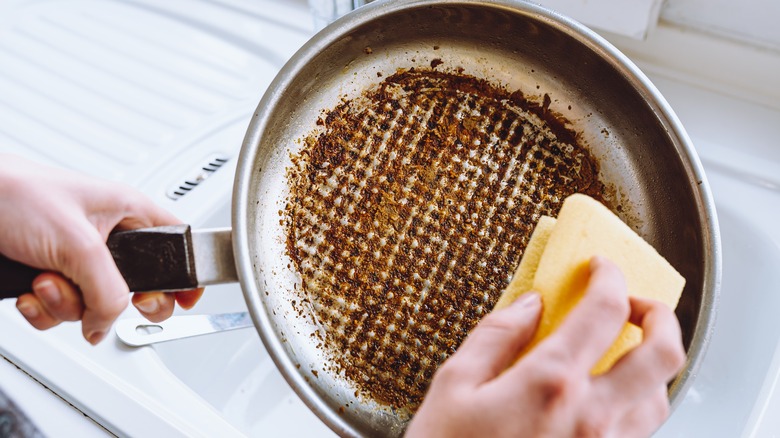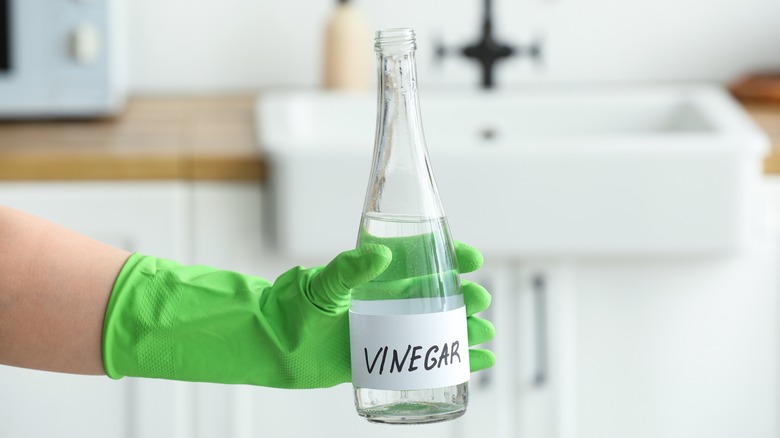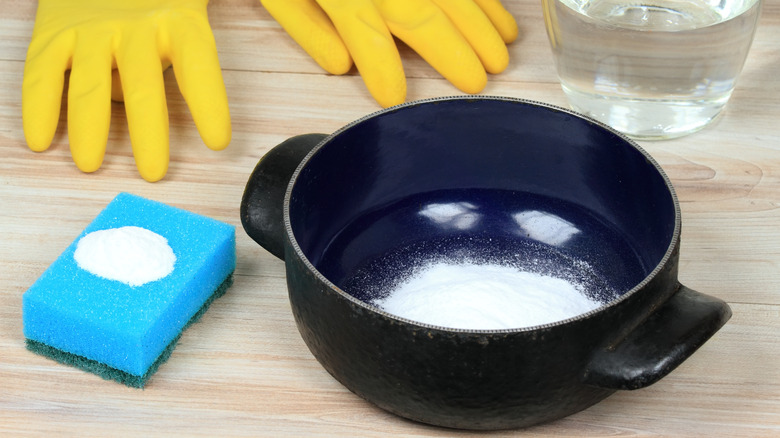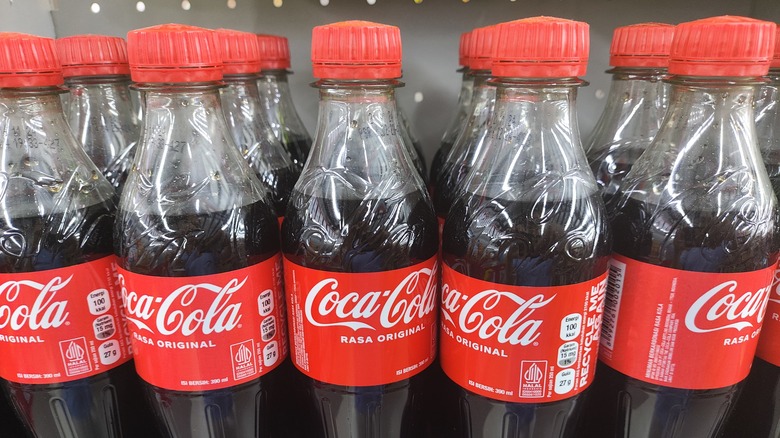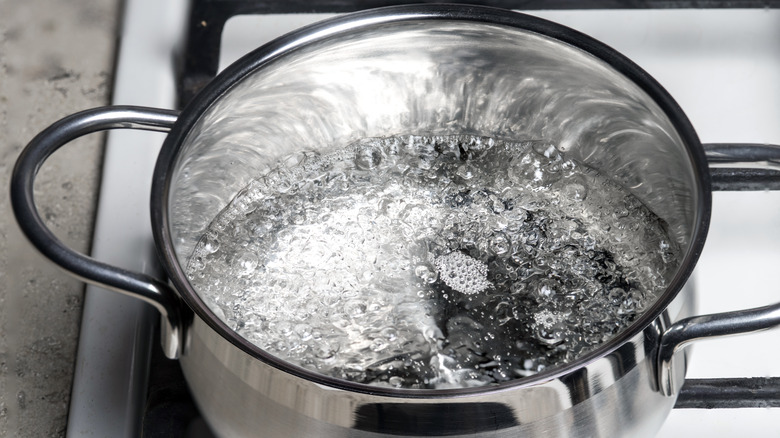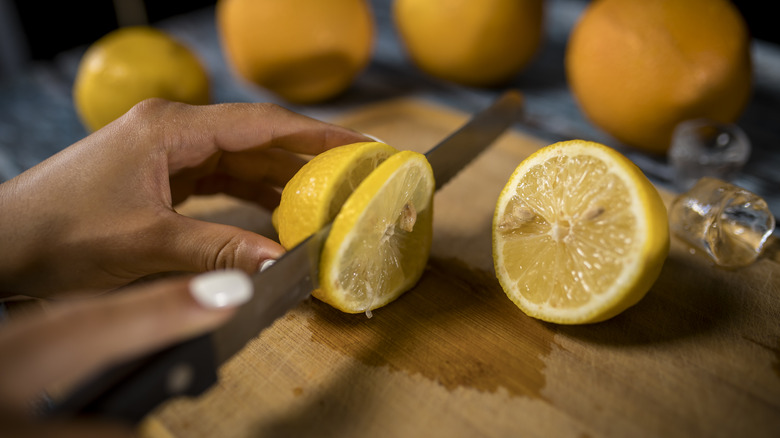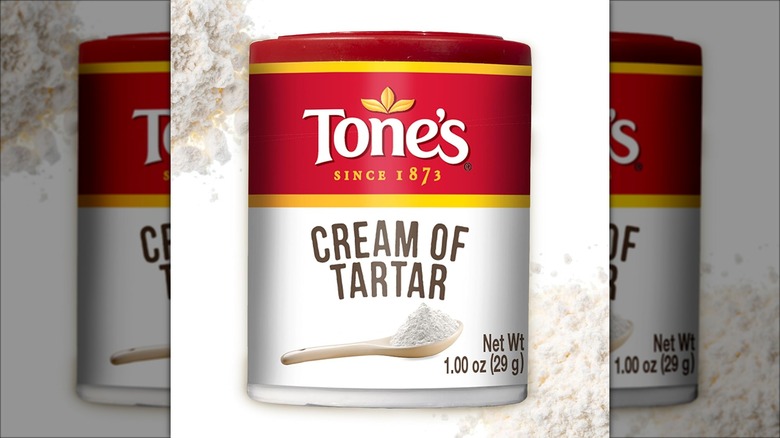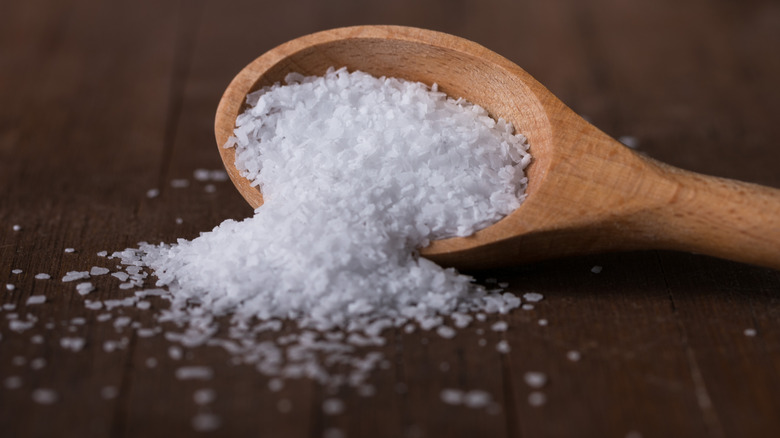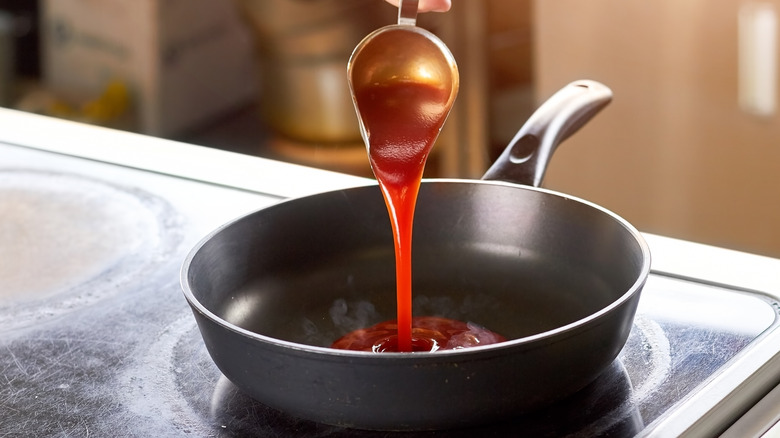8 Kitchen Ingredients You Can Use To Clean Burnt Pans
We may receive a commission on purchases made from links.
We've all been there. You leave a pot of sauce cooking on the stove and forget to turn it down (or thought you had it down enough, but were wrong). Or, you make a common popcorn-making mistake and burn the kernels — and your pan — at the same time. By the time you go back into the kitchen to check on your food, it's too late. Whatever you were cooking doesn't look anything like it did when you walked away. It is dark, hard, and stuck all over your cookware.
If this happens to you, don't panic. While it may seem like a tragedy that the old, burnt pan looks ruined, all is unlikely lost. You can often clean all the gunk and residue off a burnt pan. And, even better, there are several ingredients, from boiling water to Coca-Cola, are likely sitting right in your kitchen, ready and waiting to give you a helping hand.
Vinegar
Vinegar can help you prepare delicious salad dressings, pickles, sauces, and more. Chances are, you have some vinegar in your kitchen right now. But, did you know that vinegar is also an incredible cleaning product? Not only is vinegar acidic, allowing it to cut through grease, dirt, and other gunk, but it is also a powerful and natural disinfectant.
To use vinegar to clean up a burnt pan, scrape off as much of the food residue possible. Then, fill a large measuring cup with vinegar and water (in a 1:1 ratio), and pour the liquid into the pot or pan. The amount of water and vinegar you'll need will vary based on the size of the pot and how far up the sides the burnt residue goes. You'll want to make sure you have enough solution to fully cover any sections with burnt-on gunk.
After adding the vinegar and water to the pan, return it to the stove and bring the ingredients to a boil. Let the water and vinegar simmer for 4 to 6 minutes so that the acetic acid in the vinegar can get to work. Remove the pan from the heat, and let everything sit for a few additional minutes before dumping the liquid and scrubbing out any remaining residue.
Baking soda
Baking soda is another power cleaning product probably sitting in your pantry right now. You can use baking soda to clean a wide assortment of items and surfaces throughout the home, including dirty cookie sheets or greasy stoneware in the kitchen. When it comes to cleaning a burnt pan using baking soda, there are actually a few different methods you can try.
One option is to make a thick paste using baking soda and some water in a 3:1 ratio. Spread the paste over any areas of the pan with burnt-on messes. Leave the paste on the pot overnight. When you return the next morning, sprinkle a little more baking soda over the area and use a scouring sponge or nylon brush (depending on the type of cookware you have) to get rid of the mess.
For major messes, skip the water and try combining the cleaning power of baking soda and vinegar. In a pot, bring some white vinegar to a boil, and then pour in about 1 cup of baking soda. After the fizzing decreases, use a nylon brush to scrub the pot and remove any burnt-on grime.
Coca Cola
If you have a few bottles of Coca-Cola hiding in the fridge, pull them out to help with your burnt pan. And, no, their job isn't to give you something sweet and tasty to drink as you get rid of the burnt-on stains. In fact, just the opposite is true; their job is to get rid of the burnt-on stains for you.
Coca-Cola is made using carbonic acid, which is responsible for the drink's fizziness. If you only have Mexican Coke, don't worry. While Mexican Coke may taste a bit different, it also has carbonic acid, so it can still help clean up messes on burnt pans. You'll need to pour enough Coca-Cola into the pan to fully cover the burnt bottom. Let everything sit overnight before rinsing and wiping out the pan.
If you're in a bit of a hurry, you can also pour the Coke in your pan while it's on a low heat. Leave it to sit for half an hour or so, and then scrub with a scouring pad.
Boiling water
Returning the burnt pan back to the scene of the crime, also known as the stovetop, might not feel like a good idea. However, adding tap water to the pan and letting it boil for several minutes will yield marvelous results. The hot water bubbling around the inside of the pot will work to release the burnt-on grime on the sides or bottom of the pot. After the time has passed, dump out the water and wipe down the inside of the pot with a sponge.
You'll be surprised with how much comes out when cleaning with water. In fact, boiling water can be used to clean several types of items in your kitchen. Just take note, you shouldn't use boiling water to clean wooden spoons; it might make them crack or even remove the oils coating the spoon and giving it antimicrobial properties.
Lemons
You know the saying, "When life gives you lemons, clean a burnt pan." Ok, maybe that isn't exactly how the saying goes, but you might want to change it after discovering how effective lemons can be when cleaning a burnt pan. For this tip, you're once again going to bring the burnt pan back to the stovetop, but first, fill it with plenty of water to cover the burnt bottom. Then, slice several lemons in half and toss them into the pan.
After everything is in the pan, turn the heat up and bring the liquid to a boil. As the bubbles move the acidic lemon water around, the burnt food should come away from the sides or bottom of the pan. Let everything boil for 5 to 10 minutes before dumping the water into the sink. Rinse away loose gunk or use a kitchen scrub brush to get any stubborn spots. In addition to leaving your pan looking clean, the natural citrus fruit cleaner will also smell fresh.
Cream of tartar
Cream of tartar may most commonly be used when preparing baked goods. The white powder is a byproduct left behind when making wine. As you may be able to guess, cream of tartar, like wine, is acidic. In addition to being a little acidic, cream of tartar is also an abrasive cleaner. This means that when you rub it against the gunk on a pot or pan, the powder's abrasive properties will help remove the grim on the tub, while the acidity can help break down messes to make them easier to remove.
To clean a burnt pan with cream of tartar, add a little water to the powder to form a thick paste (it doesn't take much water). Spread the paste over the affected area(s) of the pan, and walk away to let the cream of tartar sit on the stain for at least 15 minutes to give the acid time to break through the grime. Next, use a cloth or sponge to work the cream of tartar into the gunky section to take advantage of the cream of tartar's abrasive properties.
Salt
If you're like many, you're probably already sprinkling salt over your food or by salting the water to cook pasta. But, salt can also help you get rid of burnt-on messes. To begin, you will want to soak the pan in warm water and a few tablespoons of table salt. Let the solution sit in the pan for 3 to 5 minutes, and then move the pot to the stove. Bring the water to a boil and let it continue boiling vigorously for 15 to 20 minutes. Remove the pan from the heat, but don't dump the water out so it can continue working. You can also add a little dish soap for some extra cleaning power before boiling the water.
Inspect the pan and see whether all the burnt-on gunk has been released. In many cases, the pan will be good to go, but sometimes it may still need a little T.L.C. Dump all but a thin layer of the salt water out of the pan, then add about three or four more tablespoons of salt into it. The small granules of salt are abrasive, so scrubbing them using a sponge should help loosen and release more of the gunk and grime. After you're certain you've removed all the burnt-on food, wash the pot as normal, dry it, and put it away.
Ketchup
Whether you refrigerate your ketchup or store it in the pantry, you might want to pull it out the next time you're dealing with a burnt pan. Spread the ketchup over the entire surface of the pan — or anywhere that it is burnt — and let it sit for about half an hour. After waiting, use a scouring pad or a pan scraper to wipe down the surface. As you wipe, you should be removing not only the ketchup but also the layer of burnt gunk beneath it.
If you've ever made ketchup or looked at the ingredient list, you know the condiment contains vinegar. Acetic acid is a prominent component of vinegar. Its pH of about 2.5 means it will likely release hydrogen compounds in water. When these compounds are released, the acetic acid is able to effectively breaks through chunks of burnt-on messes. In addition, the thicker consistency of ketchup helps it stay on the burnt sections, meaning you'll get a deeper clean.
